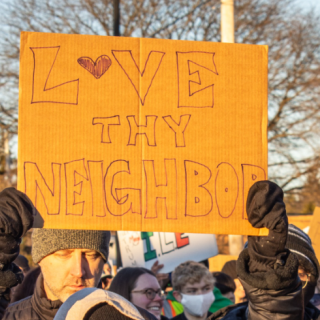Advertisement
It’s been a long circuitous journey. From 2011 to 2016, the word “medical” prefaced all submitted, rejected, or certified marijuana-related ballot initiatives in Ohio. All were proposed as constitutional amendments. Then, in March 2020, during the pandemic, the concept of regulating marijuana like alcohol emerged in an amendment that the Ohio Attorney General (OAG) rejected. A year and a half later in August 2021, the OAG did certify the Act to Control and Regulate Adult Use Cannabis (a resubmission) for signature gathering as – for the very first time – a citizen initiated statute. That meant game on for adult use cannabis in Ohio.
Over the past two years, the Coalition to Regulate Marijuana Like Alcohol (CRMLA), a statewide ballot issue PAC, has collected almost a half million total signatures in three phases for its Regulate Marijuana Like Alcohol (RMLA) initiative.
For the first phase, the campaign submitted 206,943 signatures to Ohio Secretary of State Frank LaRose (SoS) in December 2021, but the SoS found that sum insufficient. The Coalition then turned in another 29,918, making the total of 136,729 valid signatures enough to trigger the second phase: presentation of the measure to the Ohio General Assembly. However, issues with timing raised in April 2022 caused the CRMLA to file a lawsuit in the Franklin County Court of Common Pleas. The settlement nixed ballot placement for 2022, but allowed the campaign to proceed with the initiative process and target the off-year November 2023 election.
The SoS presented the initiative to the legislature in January 2023 where it sat untouched for four statutory months. With no legislative action, the CRMLA commenced the third phase in May 2023: collection of another round of signatures for placement on the fall ballot. The group submitted 222,198 signatures in 254 boxes to the SoS on the July 5th deadline. But it again fell short, this time by 679 of the 124,046 required. The submitted signatures did meet the 44-county requirement. Fortunately, the campaign could avail itself of the 10-day “cure period” to make up the shortfall.
And make it up, they did. Mobilized and energized supporters collected 6,545 total signatures within the short cure period of which 4,405 were valid, thereby eclipsing the required 124,046. With that, the SoS in August “direct[ed] the boards of elections to place the proposed law on the November 7, 2023 General Election ballot.” The CRMLA and the Ballot board will next craft pro and con ballot arguments. Citizen-initiated statutes need a simple majority of 50%+1 to pass and, if approved by voters, go into effect 30 days after the election.
WILL RMLA PASS? The polling
A recent public opinion “poll of 500 likely voters in Ohio” from Suffolk University/USA Today (page 21) found a significant 59% of support allowing “adults 21 years of age or older to buy and possess marijuana,” with 35% opposing and 7% undecided. Interestingly, this same poll queried support for Issue 1, a proxy for reproductive rights, that lost at an August special election by a margin of 57-43%. The issue would have raised the passage margin to 60% to thwart those rights. The poll accurately predicted this measure’s result, showing that 57% opposed it while just 26% were in support and 17% undecided (page 20). In addition, the poll asked about the reproductive rights amendment that made the ballot on 7/25/23. Here, respondents expressed similar support at 58% for the amendment, 32% opposed, and 10% undecided (page 22).
INITIATIVE SYNERGY – Reproductive rights + RMLA + Issue 1
The aforementioned polling suggests that the two ballot measures – reproductive rights and adult use cannabis – might be synergistic with one another. Demographically, young people under age 35 and minorities represent the strongest supporters of both issues. Conversely, the strongest opposition belongs to those who are white and over age 65. Oftentimes, older individuals are more consistent, regular voters. But younger voters outnumber them and are more passionate about the two issues. The energy created by Issue 1 that brought them to the polls in August may well spill over to the November general election.
OPPOSITION – The Usual Suspects
Affiliated with the opposition’s political action committee (PAC) called Protect Ohio Workers and Families are Children’s Hospital Association, the Ohio Adolescent Health Association, Buckeye Sheriffs Association, Ohio Association of Chiefs of Police, Ohio Prosecuting Attorneys Association, Ohio Veterans First, Veterans Court Watch and Smart Approaches to Marijuana. Other opponents include the Center for Christian Values and Ohio Veterans United. A Mary Jane’s Guide article about “Oppo” in the September 2021 Free Press described these organizations and their funding in detail.
The opposition PAC described the RMLA as “today’s version of Big Tobacco — big corporations getting rich at the expense of our kids and society.” A steering committee member went on to complain, “Expanding access to this addictive drug brings even more risks to Ohioans, especially for employers who prioritize a safe workplace but already struggle to find workers who can pass a drug test.”
Of course, Ohio’s governmental “trifecta” opposes RMLA. For example, Ohio Governor Mike DeWine recently declared, “It would be a real mistake for us to have recreational marijuana,” calling Colorado an "unmitigated disaster” … despite the $315 million it earned in 2022 tax revenue. The governor has gone so far as to vow a veto of bills to fully legalize marijuana in Ohio.
Ohio Senate President Matt Huffman (R-Lima) has also panned adult use cannabis, claiming that “no road to recreational marijuana will run through him.” He told the Columbus Dispatch, “I’m not going to bring it to the Senate floor.”
Rep. Jamie Callender (R-Concord) agreed, “There are a number of legislators who have publicly commented that they will block marijuana in any way they can … this is a bad idea.”
The negative positions of the governor, Senate president, and other trifecta legislators could be problematic. Since RMLA is an initiated statute – not a constitutional amendment – those officials could make it “DOA” upon arrival at the Statehouse no matter how many millions of Ohioans vote in favor. With just a majority vote, the trifecta that is the Ohio General Assembly could engage in legislative alteration and kill the bill without recourse. Whether they will or not – especially considering Issue 1’s stunning defeat – is an open question.
STATE RECOGNITION? – Budgets and bills
There are signs, however, that the State recognizes the real possibility that RMLA will pass. For one, on July 4th, the state operating budget included a clause establishing a Division of Marijuana Control within the Department of Commerce. The transition is to be complete by the end of the year. RMLA creates such a division, as does H.B. 168, the Enact Adult Use Act. Reps. Jamie Callender (R-61) and Casey Weinstein (D-37) introduced this bill on 5/8/23. It was assigned to the Finance Committee with no further action.
CAMPAIGN FINANCE
The Coalition to Regulate Marijuana Like Alcohol (CRMLA), a statewide ballot issue political action committee (PAC), has so far filed four campaign finance reports: Annual January 2021, Semiannual July 2022, Annual January 2022, and Semiannual July 2023.
The Annual 2021 report submitted in January 2022, showed total contributions of $1.3 million and expenditures of $1.1 million. At $690,000, Washington, DC-based Marijuana Policy Project (MPP) held the position as largest donor. Other contributors included Ohio cannabis industry operators Standard Wellness, Buckeye Relief, and Klutch Cannabis (ATCPC of Ohio). The lion’s share of expenditures at a little over $1 million went to Advanced Micro Targeting for petition management.
Because the campaign laid dormant for much of 2022, the listed amounts in the Semiannual and Annual reports for that year were fractions of the earlier 2021 report. Contributors were mostly the same; the expenditures went toward legal services and bank fees.
The Semiannual July 2023 report revealed a reinvigorated campaign with $2.96 million in contributions and $3 million in expenditures. MPP gave the largest donation at $1.6 million. Industry players like Cresco Labs, Certified Cultivators, and Pure Ohio Wellness provided about $525,000. Individual contributors, some with industry affiliations, accounted for $760,000. At $3 million, almost all expenditures went to Advanced Micro Targeting.
The recently formed opposition PAC, “Protect Ohio Workers and Families,” so far has only designated a treasurer. Little will be known about contributions and expenditures until three weeks before the fall election.
RMLA – Features and benefits (or lack thereof)
The “regulate marijuana like alcohol” approach has been foundational to the legalization and hence regulation of adult use, aka recreational cannabis. The model was written into the very first ballot initiatives in Colorado (legalized 2012) and Alaska (legalized 2014). It’s a private for-profit model that doesn’t always follow “best practices” for either alcohol or tobacco. Those practices in the model typically include conflict of interest, taxation, education (youth-based and problematic users), warning labels, and research.
Here's a summary of RMLA’s Key Points. More of them can be found here. Numbers in parentheses () are sections of the Ohio Revised Code as listed in the statute’s language.
- Possession maximums. Two and a half ounces of plant material and/or fifteen grams of extract. May purchase per day amounts that do not exceed overall possession limits. (Section 3780.36) Note: this amount is way under the ninety-day supply permitted by Ohio’s Medical Marijuana Control Program, which can reach eight-ounces. Recall, the medical program will remain intact after adult use is implemented.
- Permissible forms. Plant material and seeds, live plants, clones, extracts, drops, lozenges, oils, tinctures, edibles, patches, smoking or combustible product, vaporization of product, beverages, pills, capsules, suppositories, oral pouches, oral strips, oral and topical sprays, salves, lotions or similar cosmetic products, and inhalers. (Section 3780.04) Note: these items can either be purchased or gifted. Smoking is permitted.
- Home Grow. An individual may cultivate and transfer six plants at their private residence or twelve plants with 2 or more residents. Landlords can prohibit home cultivation. (Section 3780.29)
- Cultivation. Allows medical marijuana cultivators with certificate of
operations to expand their current facilities to 100,000 square feet (Level I) and 15,000 square feet (Level Il). Creates new Level III adult use cultivator that can have up to 5,000 square feet in growing area. (Section 3780.07) Note: These small cultivation sites are good for artisanal growers.
- Dispensaries. Level 1 and Level II cultivators can have dispensary licenses at the location of their cultivation facilities. (Section 3780.10)
- Social Equity. Establishes a broad-based social equity program including an advisory group, record expungement, and funding for criminal justice reform. Allocates equity licenses to forty level III adult use cultivators and to fifty adult use dispensaries. (Section 3780.18)
- Taxation. 10% “adult use tax” paid by purchasers at adult use dispensaries. Tax revenues allocated to five funds. (Section 3780.23) Note: Tax proceeds could exceed one hundred million (See Colorado). Under the RMLA plan and aside from covering operating costs, monies will be allocated to social equity and jobs; to local municipalities and townships; and to mental health services.
- Protections. 1) no disciplinary action can be taken against professional or occupational licenses, including concealed handgun licenses; 2) no field sobriety tests or suspension of driver’s license solely for adult cannabis use; 3) cannabis cannot be used in determining child abuse or custody; 4) cannabis use cannot disqualify medical care or transplants; 5) cannabis cannot be the sole reason for rejection as a tenant. (Section 3780.33)
- Employment. Unfortunately, employers will still be able to discipline employees for their cannabis use and enforce drug testing, drug free workplace and zero-tolerance policies. Employees cannot sue. (Section 3780.35) Note: This is mostly the same as Ohio’s current medical marijuana program, sadly. If cannabis is to be regulated like alcohol, then employees should be free from drug testing and able to accept Workers Compensation or Unemployment benefits just like those who use alcohol.
An analysis of the RMLA would be incomplete without input from the Drug Enforcement and Policy Center, part of the OSU Moritz College of Law. They have comparison tables, analyses, and pros and cons about the facets of initiatives and legislation. One OSU study found that the RMLA plan could generate between $276 million and $403 million in tax revenue after five years.
In the final analysis, the tea leaves look good for the Regulate Marijuana like Alcohol initiated statute in Ohio’s fall general election. The stunning August defeat of Issue 1 showed that Ohio voters can pass honest common-sense initiatives, or reject ones that are steeped in hyperbole, dishonesty, and authoritarianism. They are tired of the War on Drugs and, in particular, the war on a simple plant. The passage of RMLA would bring the total number of states with adult-use programs to 24, and including Ohio, that would make three just this year. The 38 states with medical marijuana laws also include Ohio. Sometime soon, a breaking point will occur where the Federal government can no longer keep its head in the proverbial sand; it will have to legalize. By sheer numbers, “We the People” will prevail. One can almost feel the transformation, and Ohio, as always, will be a tipping point.
IMPORTANT LINKS
Here is the full text of the Regulate Marijuana Like Alcohol statute.
Here are bullet points that outline the RMLA’s provisions.
Here is a document that overviews the initiated statute process using the RMLA as an example.
Here is the legislative language of H.B. 168, the Enact Adult Use Act.
Here is Mary Jane’s Guide “Initiate this: Adult Use Comes to Ohio.” December 2022. Deep dives into the RMLA.
Here is Mary Jane’s Guide “Just Say NO! to Issue 1.” May 2023. Covers Issue 1 and the RMLA, offering a historical backdrop.
Here is Mary Jane’s Guide “UPDATES: Issue 1 – RMLA – Courage in Cannabis Launch.” July 2022. Updates Issue 1 and the RMLA.
COURAGE IN CANNABIS – BESTSELLER UPDATE
The July launch of Courage in Cannabis, Volume 2, The Triumphant Stories went spectacularly. This second book in the Courage in Cannabis series has won #1 Bestseller in seven Amazon categories.
Courage in Cannabis is the brainchild of Dr. Bridget Williams, M.D., who published Courage in Cannabis: An Anthology of Inspiring Stories Written by Heroes in 2021. The new volume, The Triumphant Stories, released in July 2023, celebrates everyday heroes who have found purpose through their relationship with cannabis. The book features contributions from doctors, lawyers, patients, caregivers, participants in the legacy market, entrepreneurs, and advocates, who candidly share their personal experiences and the lessons learned from their journey. The stories show that, even in challenging times, perseverance, resilience, and courage can shine through.
The anthology has also garnered support from several important sponsors, including BLEV 614, SupHerbs Herbal Center, Dagga Digital Marketing, Endo Cannabis Centers, Hemp Box Etc., Columbus Botanical Depot, OMMPA (Ohio Medical Marijuana Physicians Association), The Canna Mom Show, CannabisBPO, Compass Natural Marketing, and Spendr.
Courage in Cannabis, Volume 2 can be purchased from Amazon in both paperback and Kindle versions. You can also order through Barnes & Noble and Walmart. The Courage in Cannabis book series is a project of the nonprofit GHH Community Foundation, a 501(c)(3).
=-=-=-=-=
WANT Adult Use MARIJUANA in OHIO? VOTE YES! at the NOVEMBER 7, 2023, General Election! Here’s how:
1. Find out if you are eligible. You must meet certain criteria to vote in Ohio: 18+ years old, Ohio resident for at least 30 days and not incarcerated, among others.
2. Check your voter registration with the Ohio Secretary of State (SoS). Click here. You can register to vote, update your address, or just make sure your information is correct. The registration deadline is October 10th. Here’s a FAQ on voting from the SoS.
3. Find out where you vote. Polling places can change from election to election. The Secretary of State provides this information here. See the clickable map or choose the Ohio county in which you reside.
4. Make your plans before you vote. You can vote in person at your polling place on election day, or in person at an early voting location starting 10/11/2023 (hours vary), or by absentee ballot requested from the Secretary of State. Here are absentee ballot instructions.
5. Mark your calendar now, make a plan, and Vote YES for RMLA!!
=-=-=-=
Mary Jane Borden is a best-selling author, skilled graphic artist, and award-winning cannabis activist from Westerville, Ohio. During her 40-year career in drug policy, she co-founded seven cannabis-oriented groups, co-authored four proposed constitutional amendments, lobbied for six medical marijuana bills, penned 100+ Columbus Free Press articles, and has given hundreds of media interviews. She is one of the Courage in Cannabis authors, with articles in both editions. Her artwork can be viewed at CannabinArt.com and she can be reached at maryjaneborden@ gmail.com.



